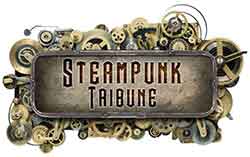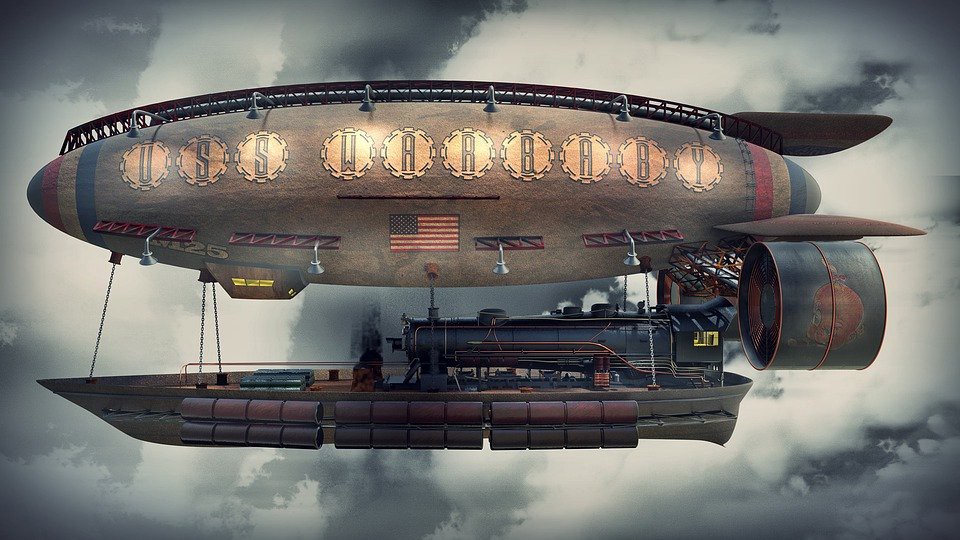Pirates in steampunk worlds present an exciting contrast between neo-medieval and futuristic themes. On the one hand, you have sea-fairing pirates (or, in this case, air-faring) that live a primitive life of raiding ships and spreading terror to make ends meet in a simple life.
On the other hand, the concept of airships is relatively modern in the real world and much more futuristic in steampunk media.
For reference, the golden age of piracy is around 1400-1800, specifically in the late 1600s to early 1700s. In contrast, the first forms of airships emerged in the 1900s with basic airplanes and zeppelins.
So how did steampunk artists realize the potential of combining those tropes in their media? And why are they so prevalent in these retro-futuristic worlds?
Fantasy in Steampunk Themes
Steampunk is famous for its retro-futuristic themes and inconsistent technologies. And I don’t mean this as a criticism. In fact, I find this exciting combination of old and new to be one of the most interesting aspects of steampunk art.
This fusion started because steampunk-themed novels and works of art began as a form of speculative fiction in the late Victorian era, where artists would envision a fantastical future with unthinkable technology that resembles their present-day with some alterations.
For instance, think of how steampunk artists often slap a zeppelin on the traditional pirate wooden ship instead of giving them, say, an airplane. This is likely because airplanes never even existed in the early steampunk days, so the artists had to be creative.
Alternate History Fantasy
Many newer artists like to explore steampunk in the form of alternate history fantasy. For example, what if computers remained analog instead of going digital? Or what if gramophones stuck around instead of new music media?
Regarding pirates, we see the prevalence of steam cannons and superlight airships that can fly. Obviously, these technologies never existed, but it’s interesting to think about how pirates could have flourished in an alternate timeline that contains these devices.
Piracy Is Often Romanticized in Media
The pirates you see in movies, video games, and other media couldn’t be farther from reality. The idea of fancy ships with strong cannons and pirates getting rich off passing trade boats is so outlandish that I’m not sure any pirate ship ever reached such a state of luxury.
In the real world, pirates live a bleak and, in most cases, unsustainable lifestyle of constant plundering, living in slum-like conditions, and eating whatever scraps they can find. It’s not as aesthetic as the media paints it, and many pirates never even make it past their youth.
Still, the mysterious lives of pirates make them an exciting theme for people living in a safe area that’s unlikely ever to get attacked by pirates. And, of course, the intense combat scenes between pirates and officials can make for an exciting watch, just like we enjoy watching medieval or space-based combat in other genres.
Moreover, the pirate archetype represents a stateless rebel that fights for their benefit and struggles with the ways of modern life. That’s another exciting trope for most people to fantasize about, even though they’ll never act upon this archetype in their lives.
Piracy Never Ended
We often think of piracy as an archaic and savage lifestyle. But in reality, piracy is still around in the 21st century. Some of the most infamous examples occur around the Horn of Africa, the Gulf of Guinea, and the Indian Ocean.
While piracy has significantly declined over the last 2-3 centuries, it’s definitely still around, unlike other rebellious lifestyles like the American Wild West outlaw.
So when steampunk artists implement piracy in their works, they’re not really reviving it from the dead but rather giving it a life boost.
Airship Pirates in Steampunk
Interestingly, the airship pirates we often see and hear about in steampunk media are mostly carbon copies of pirates from the golden age around the 18th century. They wear the same outfits, operate similar-looking ships with flying vehicles attached to them, and use similar weaponry but with steam power.
That’s because the stereotypical pirate aesthetic is more appealing and fitting in steampunk worlds than a more realistic or futuristic representation of pirates. And here, we see the power of romanticized tropes once again.
Perhaps a more realistic pirate in a futuristic steampunk world would fly around in a hot air balloon, zeppelin, or even a themed airplane.
Or maybe they wouldn’t even rely on flight and instead, use steam-powered land vehicles to move around and plunder freight trains. Who knows?
No Privateers in Steampunk
As far as I know, no popular steampunk artist depicts privateers in their work. Even artists known for their heavy use of pirate tropes and aesthetics don’t do this.
This is interesting because privateers were basically government-sponsored pirates that did the same things as “freelance” pirates. And although they lived a much more comfortable life than your stereotypical “ahoy, matey!” pirate, this isn’t really saying much.
This is probably because privateers don’t represent the same archetypes as pirates.
Since privateers are government-led and backed, they’re seen more similarly to police officers or even the military. In other words, they’re a part of the government, don’t break the rules, and live a life of rebellion like the other “cool” pirates.
Final Words
Piracy represents a romantic set of traits that appeals to many people and artists. And considering the time at which steampunk artists started to emerge and the popularity of pirate tropes, it’s no surprise we see an exciting fusion between medieval golden age pirates and futuristic steampunk technology.
Pirate-related technologies like steam cannons and lighter-than-air ships give us a fascinating insight into what might have been if things had gone differently.

